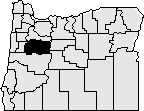
On Dec. 28, 1847 the Provisional Legislature created Linn County from the southern portion of Champoeg (later Marion) County. The boundaries were altered in 1851 and 1854 with the creation of Lane and Wasco Counties.
The county consists of 2,297 square miles and is bounded on the north by Marion County; on the east by Deschutes and Jefferson Counties; on the south by Lane County; and on the west by Benton County. Linn County was named for U.S. Senator Lewis F. Linn of Missouri who was the author of the Donation Land Act that gave free land to settlers in the West.
The county seat was originally located in Calapooia (Brownsville), but in 1851 the Territorial Legislature passed an act establishing Albany as the county seat. A special election in 1856 reaffirmed Albany as the county seat.
The Spaulding School in Brownsville served as the first courthouse. A new courthouse was built in Albany in 1853 but was destroyed by fire in 1861. A third courthouse was built in 1865 and remodeled in 1890 and 1899. The present courthouse was constructed in 1940 adjacent to the earlier courthouses.
The general administration of Linn County business was placed in the county court, composed of two elected commissioners and a county judge. The county court met for the first time in December, 1849. In 1970 the county court was replaced by a board of county commissioners. Current county officials include three commissioners, district attorney, assessor, clerk, sheriff, surveyor, and treasurer.
The population in 2016 was 122,315. This represented an increase of 4.8% over 2010.
The climate and soil conditions provide one of Oregon's most diversified agriculture areas, allowing specialty crops such as common and perennial ryegrass. Linn County is also home to major producers of rare and primary metals, processed food, manufactured homes and motor homes as well as the traditional logging and wood products industries.